Abstract
In Romania the Law of Education published in 2011 includes procedures for both the formal and non- formal education. The non- formal education enables the partial or total development of certain competencies, they actually help the formal education. In the Romanian school system the non- formal education has been existing till the 1950s. In the 1990s the main aim was the teaching and learning of subjects on an academic level, while the personality development should have been crucial as well. Non-formal education is now complementary to formal education. We are examining in the present research, if, according to the teachers, the non- formal education has had any effect on Sciences. The other issue to examine is, whether the knowledge gained through experiencing helps thinking? What is the lower – secondary teachers’ opinion about the competency- based education? We used an online survey among the teachers of Covasna county working both in formal and non -formal institutions. The study notes that many teachers, children and parents believe that the non-formal activities play an important role in educating Generation Z students and especially in developing key competencies. The results of the survey show that the non-formal experience based learning style, hand in hand with the formal one, helps in the development of the scientific thinking of students.
Keywords: Educationskillsformalnon-formal methodsnatural sciencesGeneration Z
Introduction
The world of science, technology and society is constantly changing. The Romanian education system has suffered changes due to technology and political changes. Due to the great flow of information and changes in the European education and within the national system, students' attitudes towards the curricular area of mathematics and natural sciences has changed. Technology change has been felt at the level of schools through educational software, experimental tools, digital textbooks. The introduction of technology has resulted the improvement of teaching-learning methods, the adaptation to the standards of technological evolution, as things cannot be improved if their functioning, their use among the next generation is not known.
Problem Statement
Competences in the field of natural sciences
The results of students' performance at the OECD-PISA 2015 exam, the lack of students at the Faculties of Natural Sciences, the results at national and final exams, the examination subjects that students choose at the Baccalaureate, all tend to express that Natural Sciences have lost ground to other subjects, it cannot be said that students are motivated to learn Chemistry, Physics, Biology, even at the level of non-formal activities, the disappearance of the technical-applicative circles has been acknowledged. The modern world needs experts in the field and the revival of these subjects, activities lies mainly in the hands of teachers and the investment in equipping the laboratories with modern equipment and specialized educational software (Organisation for Economic Co-operation and Development. 2016).
The role of pedagogical society within natural sciences is to know how Z generation thinks, to find the factors that generated the gap, the estrangement from the respective subjects. Motivation towards the natural sciences, the development of logical thinking, of creativity, rediscovering the beauty of Chemistry, Physics, Biology, of extracurricular activities in which the sense of beauty, skills are developed, are just a few guide marks for which the answer is sought (Daniel, 2015).
From the results of the national and international TIMSS and PISA assessments, an indicative conclusion can be drawn regarding the use of the appropriate teaching-learning methods, the teaching tools that require change, learning units which need to be redefined, or the fact if the curriculum meets the level of international standards and if the Romanian education is in line with the methodology used by international exams.
Tracking the results of the exam, the educational process should not trace only the students' attitude towards one subject or another.
Observing, perceiving phenomena that occur around us, chemical processes, physical and natural phenomena must be rediscovered in each child's vision in order to understand and apply it to the modern world (Bocos, 2017).
The laws of physics, the structure of the atom, the cell, they all have the same characteristics, the same structure as 20-30 years ago, but to be understood by the Generation Z, the methods must be changed by combining the traditional teaching methods with the modern ones (Albulescu, 2008). Children of the generation of the modern world have other forms of understanding things, and they are the ones who will work around 2030 with robots, with modern technology and will seek to moderate artificial intelligence. We need to move on to modern teaching methods and from the concept of ”what to learn” to that of ”for what to learn”, the continued stimulation of interest in science and technology by creating a balance in the teaching-learning-evaluation process regarding formative and informative character (e-isteti.ro.2015). In order to develop critical thinking, along with creativity, active-participatory strategies must be used, and the modernization of educational strategies should be coordinated in such a way that there is no rupture from the traditional ones (Albulescu, 2008).
In the world of natural sciences, the instructive-educational process is slightly different from other curriculum areas and must be treated separately by the "principle of connecting theory and practice" and "the principle of correlation with life" (Alexandru, 1999, p.119). The modern world is changing and "the requirement is that, what is learned and gathered in the educational process, is to be used by applying it to solving later tasks and integration into society." (Nicolae, 1994, p. 289).
Through teaching-learning activities of Natural sciences, teachers must pursue a rediscovery of the world, of the natural phenomena, or the storage of scientific information that can infer new concepts, as well as the student's reporting to the environment in which he/she spends his/her daily life.
In order to achieve ecological education, protecting and preserving the environment is an important part of natural sciences. The competencies that intend to develop the curriculum and the non-formal activities, according to the Order of the National Education Minister no. 3393/28.02.2017, on approving the curriculumfor Social Education for 5-8th Grades, referto communication, understanding and use of scientific information, the relation between the natural and the social environment. Developing attitudes towards one's own health, the health of others, the interest in logical appreciation, creativity, developing logical, independent thinking, environmental concern is an integral part of the curriculum. (Albulescu, 2008).
An important role in the development of competences and attitudes in the field of natural sciences play the activities of the scientific and technical circles within the Children`s Palace and Clubs, through the complementarity that they add to the formal activities within the education programs which aim at using the information they receive within these activities for the uniform development of eachchild's personality.
The Programme for International Student Assessment (PISA), organized by the Organization for Economic Cooperation and Development (OECD), takes place every three years and evaluates 15-16 year-olds in domains as mathematics, reading and science and "assesses the extent to which students can apply the information they have learned at school in the real world "(OECD, 2017, p..25). It does not pursue the efficiency of performing a curriculum, it rather assesses the level of key competences, knowledge, basic skills children have at the end of compulsory education in order to continue their studies, to what extent they can participate in social life, in the community they come from, or in the labor market. The results of the Organisation for Economic Co-operation and Development (2016), on Science, according to the OECD, were 435 points compared to the OECD average score of 493 points, and the best score, that of Singapore, of 558 points. Top-ranked countries have an economic prosperity and an industry with modern technology. In the field of Science, the results improved significantly between 2006 and 2012 "Excellence and Equity in Education" (volume I) but there is a slight decrease, not significant, in 2015. The motivation to learn natural sciences is in decline, not only in Romania, but also in some EU Member States, fact recorded also in other countries' statistics. There is no rule, but the listed criteria can result various hypothesis.
China's technology-based dumping, one of the first in the PISA ratings, its low price, lack of hunger for technological knowledge, the lack of patience of the Z generation, has caused a dramatic drop in the technical and scientific circles within the Children's Palaces and Clubs in Covasna County (Nemeş, 2017). In parallel, children's interest in the curriculum of mathematical and natural sciences was also diminished, mathematics being the subject of exam at the end of the middle school cycle, the motivation for the respective field being an external one, namely the admission to a high school. An important role in the lack of internal motivation to learn chemistry, physics and biology is played by the parents, who guide the students towards a theoretical high school, humanities major, without knowing their intellectual capacity, and so the technological high schools lack the students, although these educational units at the level of Covasna County are very well equipped and have well trained teachers with specialized laboratories for the respective professions (Fătu, 2007).
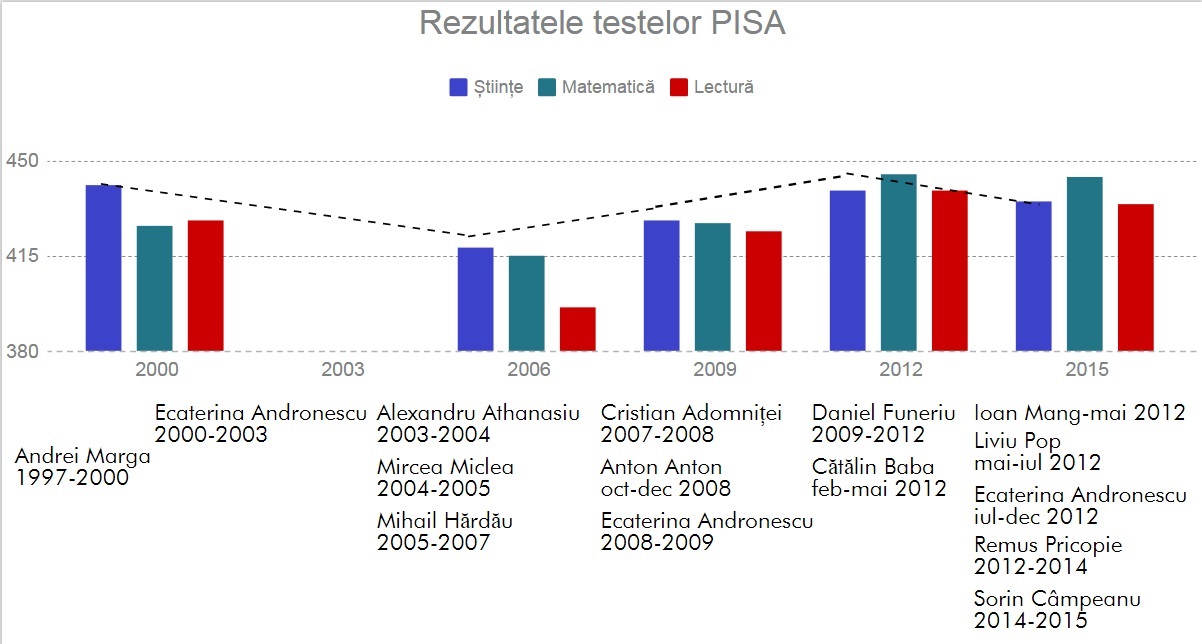
Research Questions
The questions that were expected to be answered were the following:
What is the opinion of middle school teachers about the effects on the development of competence regarding Science?
To what extent do non-formal activities contribute to the development of competences related to natural science?
At the level of middle school, what are the formative and informative valences of modern teaching methods regarding the study of natural sciences within the Children's Palace and Clubs?
Purpose of the Study
The purpose of the questionnaire was to make teachers aware of the regression of natural sciences in Covasna County and to achieve a more meaningful vision among teachers within the curricular area of mathematics and natural sciences on the introduction of school curriculum focused on the 8 key competences, to find the role of non-formal activities that would help motivate children with regard to those subjects and find solutions to achieve better results at national and international assessments, to renew the modern teaching methods used by teaching staff to better approximate the generation of the modern world, to motivate students for the importance of knowledge of phenomena, modern technology and to reduce functional illiteracy among children. It can be said that the main factor in the informational revolution is the informational crisis (Capita, 2007), as children have reached the limit of possibilities of receiving information. The storage and use of information cannot be achieved through national assessments that are based on standards that without prior knowledge, without a dose of internal motivation, cannot improve the motivation of students to learn and especially to learn natural sciences or to attend courses of non-formal activities.
Research Methods
The online questionnaire was conducted between February-March 2018 in Covasna County on a sample of 102 Chemistry, Physics, Biology and Pedagogue teachers from the Children's Palace and the Children's Clubs with circles in the field of natural sciences.
Findings
The number of teachers within the curriculum field of mathematics and natural sciences is of 150 teachers teaching chemistry, physics and biology, including professors of scientific- technical circles within non-formal activities at county level.
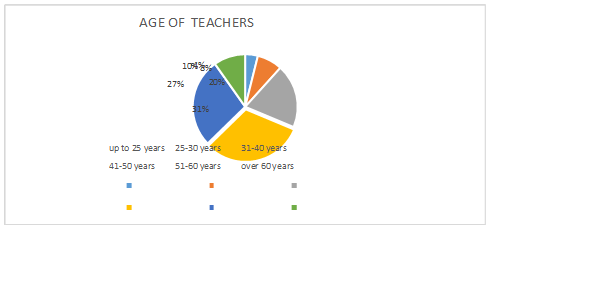
Teachers 'age should not affect students' motivation to engage more in science, but it can be noticed that 68% of teachers are over 40 years old. The problem is not the age, but rather the lack of young teachers, students who would become teachers in the domain of natural science. This can be seen at the level of Covasna County, 10% of teachers will retire within the next 3-4 years and there is no alternative, therefore professional reconversion would probably be a fact that should be taken into account by the School Inspectorate, through programs of professional reconversion and financial support for these trainings. There are 11.8% debutants in the field, and I.Ş.J.Covasna's (Covasna County School Inspectorate) statistics from 2017 reveal that in the last two years no one has registered for permanent teacher certification, which means that in the domain there are only debutant teachers with Baccalaureate or young pedagogues, who are not motivated to develop their skills through professional training, although a higher education degree also means financial benefits.
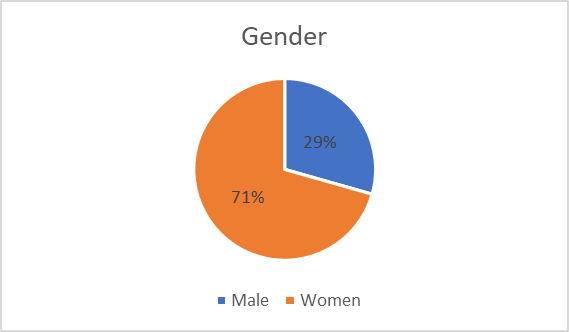
Gender equality has changed in education and natural sciences to the detriment of teachers, according to the Census of the population and housing of 2011. In the last 30 years, the percentage of male/women teachers in the field of natural sciences have reversed, and almost a third of the teachers are males. The pupils' results are not affected by this impediment, possibly in the technical scientific circles, we can say that the activities at the level of Covasna County are not attracted by the beautiful gender, probably by the lack of practical skills that keep away from the extra-curricular activities. It can be said that there is a lack of female teachers in the field, fact also stated by I.Ş.J.Covasna's statistics (School Inspectorate of Covasna County) through the list of vacancies and the list of the teaching staff registered at the tenure examination from 2016, 2017, 2018. The acute lack of interest towards natural sciences do not derive from gender equality or the age of teachers, but the fact that in the last 10 years, at the level of Covasna County, from 15 scientific technical circles there are only 6 left, and there are fewer students who choose to go to faculties, is alarming, fact also mentioned by the statistics of I.S.J. Covasna (Covasna County School Inspectirate) 2017.
This concern exists both at the European level, as well as in the Romanian education, and the lack of interest towards the natural sciences also results from the questionnaire conducted at country level.
Lack of interest towards the tought subject is the first obstacle faced by teachers in formal and non formal education, 53.9% of teachers considered a first obstacle, followed by absenteeism 34.3% and children with special educational needs 27,5%. Upon CES (The Economic and Social Council of Romania), the questionnaire refers to hyperactivity or latergia, lack of concentration or patience of students, as well as to children who can solve the problem, but cannot apply it in practice, respectively to functional illiteracy among children from the VI, VII and VIII-th Grade. The issues listed in the questionnaire do not refer to children with mental disabilities, there are many children who have the capacity to understand the problem, the information, but because of some psychic factors they are overwhelmed by tasks and simply give up, they remain indifferent to school, have no interest for knowledge, they are bored and often abandon school, or the respective circles.
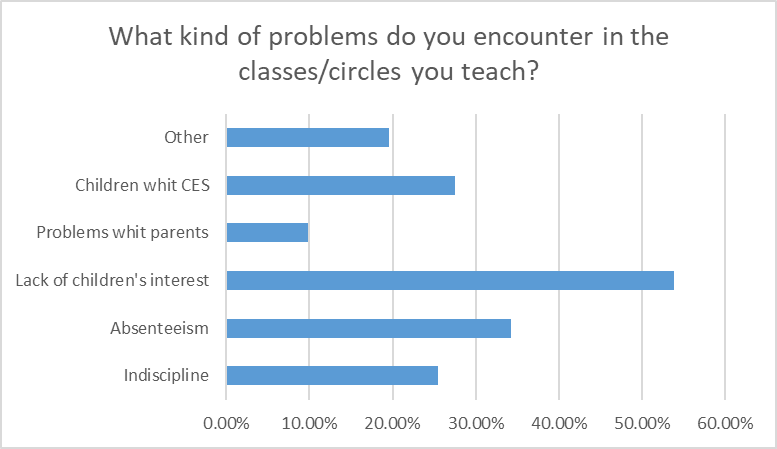
Studies in the field of educational sciences, school psychologists, who are very rare, of 2238 teachers 27 school psychologists, that means only 1.20%, so a very small number, are meant to find the best modern methods and procedures in view of achieving the proposed objectives.
Passing the priority given to the subject to the favouring and prioritization of the student (Clasen & Bowm, 1974) depends on the teacher, the methods, techniques, the modern teaching and evaluation tools that are used in the instructive-educative process and with the help of which students can be motivated.
Modern technology, educational software, experiments simulation programs come to help teachers. The lack of these modern tools aggravate the current situation of the Romanian education. Obsolete and in many cases non-existent equipment in schools, the lack of specialized laboratories, disadvantage pupils, especially from rural areas. In the school year 2016-2017 the total number of secondary school pupils was of 8650 of which 4293, namely 49.63% learn in rural areas and in time there will be an acute shortage of experts in the field, especially in rural areas.
Children's interest in the field of mathematics and natural sciences is influenced by several aspects, such as the intervention of "experts in the field", the awareness among parents, the inclusion of civil society in debates, school psychologists, technology investments, educational software, professional training, these being just a few examples that would keep the field of natural sciences on track.
The Law on National Education 1/2011 states: "The National Curriculum for Primary and Secondary Education focuses on 8 key competences that determine the student's training profile", (Annex 2. OMEN No. 3393 / 28.02.2017) and applies in the education system starting with the school year 2017-2018, being the continuation of the Law on National Education 1/2011 for gymnasium (grades 5 to 8) and school curriculum, being structured on the eight areas of competence.
The advantages of the competence-based curriculum can be of legislative, scientific, methodological, of value and evaluative nature. Contents can be structured in a modular and interdisciplinary approach, depending on the particularities of the student, thus motivating children to be interested and develop their own personality according to their own mental capacity, and to develop their general culture and knowledge in the field of natural sciences, fact also mentioned in LEN (The Law on National Education) no. 1/2011.
Learning by developing the 8 key competences involves combining modern and traditional methods to meet the needs of students and of modern society.
Introducing the competence-based curriculum marks changes among teachers and students. Starting with the school year 2017-2018, the 5th graders have learned according to the new curriculum, based on the 8 competences, and the national curriculum of 3rd and 4th graders included natural sciences and introduction into the world of science. The curriculum will require improvement after each cycle, so that by interdisciplinarity and the finalization of studies to carry out activities that form and develop the child's personality.
The rupture that exists between the primary and secondary education is observed also in regards of natural sciences. 5th graders have encountered difficulties in understanding the subject matter, difficulty which is caused primarily by the fast rhythm set by school curriculum. The new curriculum seeks to unify the large discrepancy between the curriculum of primary and secondary education and focuses on the formation of key competences as a whole, focusing on the pupil as the main role of education.
Secondary school teachers have to adapt to the new school curriculum, along with the changes that will take place upon the introduction of the new national curriculum.
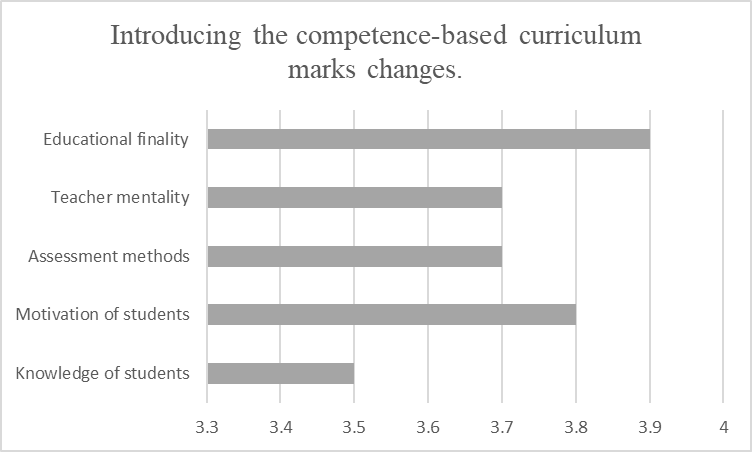
Source Questionnaire
An important change from the point of view of teachers from Covasna County will be the completion of education. Teachers' responses regarding the introduction of the competence-based curriculum and the segments in which changes will take place were made using a Likert scale. Regarding the average values, there is a positive deviation of 3.9 in the improvement of the educational completion through intellectual training, the formation of abilities and competences in the field of natural sciences, multidisciplinarity and interdisciplinarity, the formation of practical skills and competences according to the theory of Bocoș, (2017).
Educational completion at the level of middle schoolis very important, "increasing the degree of independence and students' responsibility" (Bocos & Ionescu, 2017, p.98.) largely depends on the methods and procedures used by the teacher during classes and activities. A highly important role in reducing the discrepancy between the methods used in the primary and the secondary cycle would be to perform activities by middle school teachers' among children from primary school. There are tendencies and it can be said that 10% of middle school teachers practice this kind of teaching, but mostly in the field of literature and modern language, there are only a few teachers from the curricular area of mathematics and natural sciences who have taught in the primary cycle. No teacher has responded positively to doing activities during the nationwide School Otherwise Program.
Students' motivation must be the catalyst of the instructive-educational process. Students of the Z Generation need to know the benefits of motivation, they need an interesting and attractive content to stay motivated. Rewarding them with good words, thematic trips, practical things, modern pedagogical tools are just a few ways teachers and parents can motivate children in trying to abolish boredom and indifference towards the beauty of the subject matter.
The results are significant regarding children's motivation, an average of 3.8 of the teachers said they could motivate secondary school students. The methods of motivation are directly proportional to the methods used by the teacher and, to a large extent, to the personality of the pedagogues. The first chemistry, physics, biology class or the first activity among middle school children, their first verbal or written assessment, first mark, first mechanism made at non-formal activities will mark their interest or lack of interest in the subject matter.
At the level of circles from the Children's Palace or Clubs, a thematic trip, a spare part of a tool or an electric circuit, a computer simulation, a demonstration flight with patterns made by teachers, anything that keeps up the children's interest and motivates them to come back next week, can be a form of motivation. In both forms of education applied in the field of natural sciences, motivation must be cognitive according to Piaget's theory (1952). It should be considered, that in many cases if children receive rewards for good grades, for example, money, objects (the higher the mark, the higher the reward), motivation will fall, leading to a significant decline in motivation, as demonstrated by Kim (1988). Regarding middle-aged youngsters, it is observed, that at the level of non-formal activities, where not always what "is much is good", it is not important to build many models or circuits, but that those models or circuits to be functional and that there is a correlation between theoretical and practical knowledge, emphasis being placed on functionality, the role of the circuit in practice, and the changes in formal learning. There must always be kept a feedback between formal and non-formal activities, so that the ultimate purpose is the development of creativity and of student's personality in parallel to the two forms of teaching.
The introduction of the competence-based curriculum brings relevant changes to the assessment methods mentioned by the questionnaire, 76% of teachers (3.7 after calculating the average), who teach natural sciences consider that the purpose of the assessment should be "sustaining and supporting the activity of learning" (Bocoș, & Jucan, 2017, p. 131).
Appreciation and argumentation of responses is most often neglected by teachers, especially in non-formal activities within the Children's Palace and Clubs. Very important in non-formal and formal activities, as well as in practical activities, in carrying out experiments, either frontal or individual, is that the assessment must be "an examination and control process of students' cognitive and practical skills" (Ionescu, 2000, p.303).
A role that 85.3% of the teachers consider to be very important play the specialized and interdisciplinary competitions, which represents a feedback both for teachers and students, being a fair self-evaluation and a source of motivation to participate more actively in these extracurricular activities. It is worth mentioning that 78.4% of the teachers have done extracurricular activities, activities that help develop technical, social skills, the cultivation of interest in the field, cultivation of young talents.
The teachers think that teachers' mentality can be changed by introducing a competency-based curriculum, and a deviation from the standard curriculum can be seen to an average of 3.7.
More than half of teachers believe in changing the mentality.
Each teacher must have an open mind and take into account, first and foremost, the interests, goals and needs of students. This can be done with professional training in the field and regarding natural sciences, a change of mentality among teachers is also very important. Under the project "Relevant Curriculum, Open Education for All" (CRED), the Ministry of National Education is helping teachers in regards of competence-based education.
In the opinion of teachers, the smallest change will intervene in the field of students` knowledge with an average of 3.58, with 0.32 less than the changes produced within the completion of education. Starting from the definition of competence, one of the most important component is the doping of knowledge, the mobilization of students to form skills and attitudes in order to develop a healthy personality. Information and knowledge must be such as to help children develop skills and abilities by cultivating a critical attitude, showing interest towards new technology, as well as finding the segment that helps shape the child's personality.
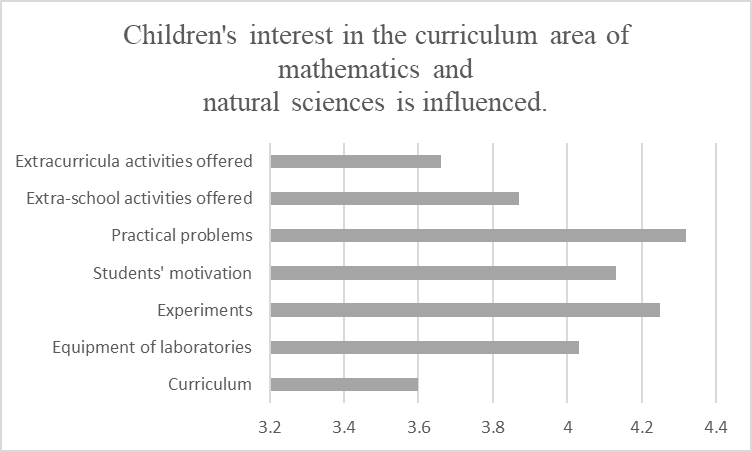
Source questionnaire
Children's interest in the curriculum area of mathematics and natural sciences is influenced by the vision of teachers regarding practical situations (4,32) followed by experiments (4,25) and child motivation (4,13). More than 80% of the surveyed teachers believe that the field of natural sciences along with modern pedagogy should be centred on pupils with an active and interactive pedagogy style, by the use of the active-participatory methods confirmed also by the specialized pedagogical research Bocoş, (2017). The experiment is the core of pupils' motivation in these subject matters, it is a research process through which children rediscover the world, observe phenomena, verify their application in practice, interpret them and, with the help of teachers, demonstrate their significant value which lies with the applicability in reality. Teachers use the method, an important fact being also the form of organizing activities, 81.4% of teachers use the method of frontal experiment and 72.5% the individual one.
The virtual experiment plays also a very important role, not only for the preservation of information but especially for the presentation of phenomena, experiments, activities that cannot be presented at classes. The role of non-formal activities is imported in the field by completing knowledge with those teaching methods that cannot be achieved during classes and come to the aid of understanding, development of knowledge and skills. Those teaching methods can become the action of the methods or can be transformed into methods, as mentioned by Cergit & Oprescu (1988).
The provision of laboratories (4.03) is directly proportional to the use of active-participatory methods and children's motivation. The lack of equipment, educational software, experiments within the instructive-educational process reduces children's interest in chemistry, physics, biology, and non-formal activities, and we cannot talk about the development of competences as an educational end.
The new school curriculum (3,6) built on key competences and child-centred depends on its use in the instructive-educational process. The modern educational strategy used, the educational offer and the CDS (Curriculum made at the decision of the school) is the educational package that helps motivate children.
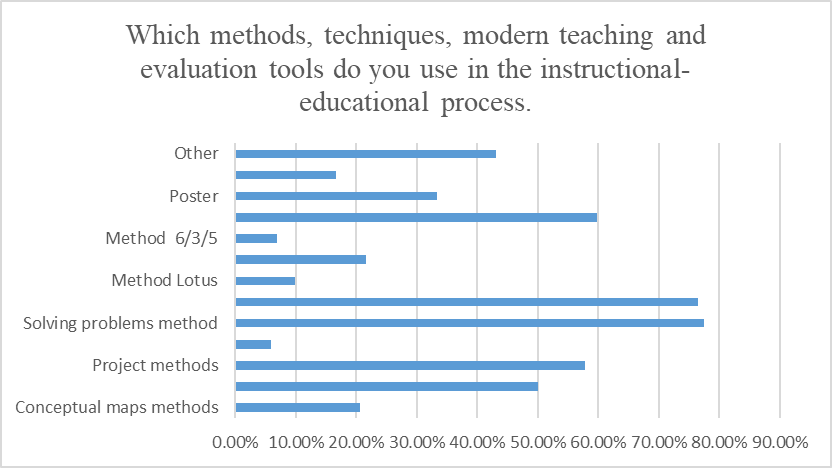
An important role in the instructive-educational process of natural sciences is to educate pupils' creativity through creative activities through which students can acquire knowledge, divergent thinking, develop their personality, interest, curiosity, attitude according to the theory of Albulescu, (2008). The use of modern teaching and assessment methods is directly proportional to the development of competence in the field of natural sciences and to the motivation of children to have a positive attitude towards these activities.
The methods which are most used by teachers are problem solving 77.5% of respondents use the respective method. Learning by discovering 76.5% and bainstorming59.8% result a better understanding of the studied phenomena of discovering the beauty of the world, of technology, the use of knowledge in technology.
In addition to the traditional methods, in 57.8% there is a use of project as well as the portfolio, in 50%, where the students' papers, worksheets, maps, and schemes are "saved".
Methods like Technique 3-2-1 and Technique 6-3-5 are the least used. These two methods can be considered a good self-evaluation modality, an alternative assessment in order to improve the lack of knowledge and they have a formative character. The questionnaire also reveals that modern methods are used not only in well-equipped schools but also in rural areas, and the most significant segment for the use of modern methods are teachers with an average age of 25-50 years. There is no basic rule, but upon analysis there can be seen a "migration" of the modern methods among the teachers mentioned above, as well as among the teachers who participated in training courses.
Conclusion
The scientific research was carried out on a sample of 102 teachers from the total of 150 who teach natural sciences in Covasna County, except mathematics, and has focused on the analysis of teachers' views on the introduction of competence-based education, which are the areas where changes will be marked and which are the external and internal factors that influence pupils' attachment to the curriculum area of mathematics and natural sciences. The questionnaire also conducted a survey of non-formal, extra-scholar and extracurricular activities that help develop children's skills and personality.
The study revealed the importance of non-formal, extra-scholar and extracurricular activities carried out in schools and in the Children's Palace and Clubs, activities that are complementary to formal activities. Children's motivation for chemistry, physics and biology is largely influenced by these extra-scholar and extracurricular activities, by the personality of teachers, and by the active methods used during classes and circles.
Combining and finding the ratio between traditional and modern teaching methods is a positive fact for teachers to raise children's motivation for the curriculum. This can be accomplished through more professional training along with the change of mentality of teachers.
The intuition of student-based learning requires, also in the opinion of the questioned teachers, the transformation of pupils from simple receptors into active "elements" of the instructive-educational process. (Harmon, & Hirumi, 1996).
Transforming teachers, especially circle leaders, into facilitators in order to find out what the child wants and transform the student into an active seeker of knowledge (Student-based learning, Guide for Teaches and Trainers 2002).
Analysing teachers' attitudes towards the introduction of competence-based learning, we can say that there is a desire on the part of teachers to change the traditional learning methods to student-centred learning methods by changing their mentality and using traditional methods in combination with modern methods to prepare the future generation for the modern world, the world of information and the motivation of the students to increase the "hunger of knowledge" offered by natural sciences, its importance in the everyday life of the children, the harmonious development of their personality, the rediscovery of the beauty of the curriculum's subjects. Using technology, increasing the quality of education, using interactive teaching methods, these all will result the increases of motivation for natural sciences, will from attitudes and will ensure the involvement in school life. The mastery, the personality and creativity of teachers represented a great help in the recovery of natural sciences and the education of generation Z, preparing them for the everyday life of the 21st century.
References
- Albulescu, I. (2008). Pragmatica predării. Activitatea profesorului între rutină și creativitate. [The pragmatics of teaching. The teacher's activity between routine and creativity]. Pitești: Paralela 45 Publishing.
- Alexandru, Ghe. (1999). Metodica predării istoriei în învăţământul preuniversitar. [Methodology of teaching history in pre-university education]. Craiova: Gheorghe Alexandru Publishing
- Bocoș, M. & Jucan, D. (2017). Fundamentele Pedagogiei, Teoria și Metodologia Curriculumului. [Fundamentals of Pedagogy, Theory and Methodology of the Curriculum]. Pitești: Paralela 45 Publishing.
- Bocoș, M. (2017). Didactica disciplinelor pedagogice [Didactics of pedagogical disciplines] Pitești: Paralela 45 Publishing.
- Bocoș, M. & Jucan, D. (2017) Teoria și metodologia instruirii,Teoria și metodologia evaluării. [Theory and Methodology of Training, Evaluation Theory and Methodology]. Pitești: Paralela 45 Publishing.
- Capita, S. P. (2007). Basarabenii în lume [Bessarabians in the world], The National Library of the Republic of Moldova. Retrieved from: http://bnrm.md/files/publicatii/basarabenii_in_lume_3.pdf
- Cergit, I. & Oprescu, N. (1988) Procesul de învățământ-cadru principal de instruire și educare a elevilor.[The mainstream educational process for educating and educating students]. București: Universitatea din București Publishing.
- Clasen, R.E. & Bowman, W.E. (1974) Toward a student-centred learning focus inventory for junior high and middle school teachers. Journal of Educational Research, 68(1), 9-11. Retrieved from https://www.jstor.org/stable/27536666
- Daniel, D. (2015) Psihologia poporului român.[Psychology of the Romanian people]. Iași: Polirom Publishing
- Fătu, S. (2007). Didactica chimiei. [Didactics of chemistry]. Bucharest: Corint Publishing.
- Harmon, S. W. & Hirumi, A. (1996). A Systematic Approach to the Integrating of Interactive Distance Learning into Education and Training. Journal of Education for Business 71(5), 267-271.
- Ionescu, M. (2000). Demersuri creative în predare şi învăţare. [Creative approaches to teaching and learning]. Cluj-Napoca: EPUC Publishing
- Kim, J. (1998). Mind in a Physical World, Cambridge, Massachusetts: MIT Press.
- Nicolai, I. (1994). Pedagogie. [Pedagogy]. București: Didactică & Pedagogică, R.A.Publishing
- Piaget, J. (1972). Psihologie și pedagogie. [Psychology and pedagog]. București: Didactica & Pedagogica Publishing.
- Importanța disciplinei Științe. (2015, august 28). [The importance of Science]. Retrieved from http://e-istet.ro/scoala/stiinte/
- Nemes, I. (2018, november 19). Raport privind starea învăţământului.[Report on the state of education]. Retrieved from https://isj.educv.ro/sites/default/files/Raport%20starea_invatamantului_ISJ_2017-2018_site%20semnat.pdf
- Organisation for Economic Co-operation and Development. (2016). PISA 2015 results, Excellence and Equity in Education. Volume I.
Copyright information

This work is licensed under a Creative Commons Attribution-NonCommercial-NoDerivatives 4.0 International License.
About this article
Publication Date
25 June 2019
Article Doi
eBook ISBN
978-1-80296-062-4
Publisher
Future Academy
Volume
63
Print ISBN (optional)
-
Edition Number
1st Edition
Pages
1-613
Subjects
Teacher, teacher training, teaching skills, teaching techniques, special education, children with special needs
Cite this article as:
Jenő, K. (2019). Sciences In The Non Formal Educational System. In V. Chis, & I. Albulescu (Eds.), Education, Reflection, Development – ERD 2018, vol 63. European Proceedings of Social and Behavioural Sciences (pp. 483-495). Future Academy. https://doi.org/10.15405/epsbs.2019.06.57

